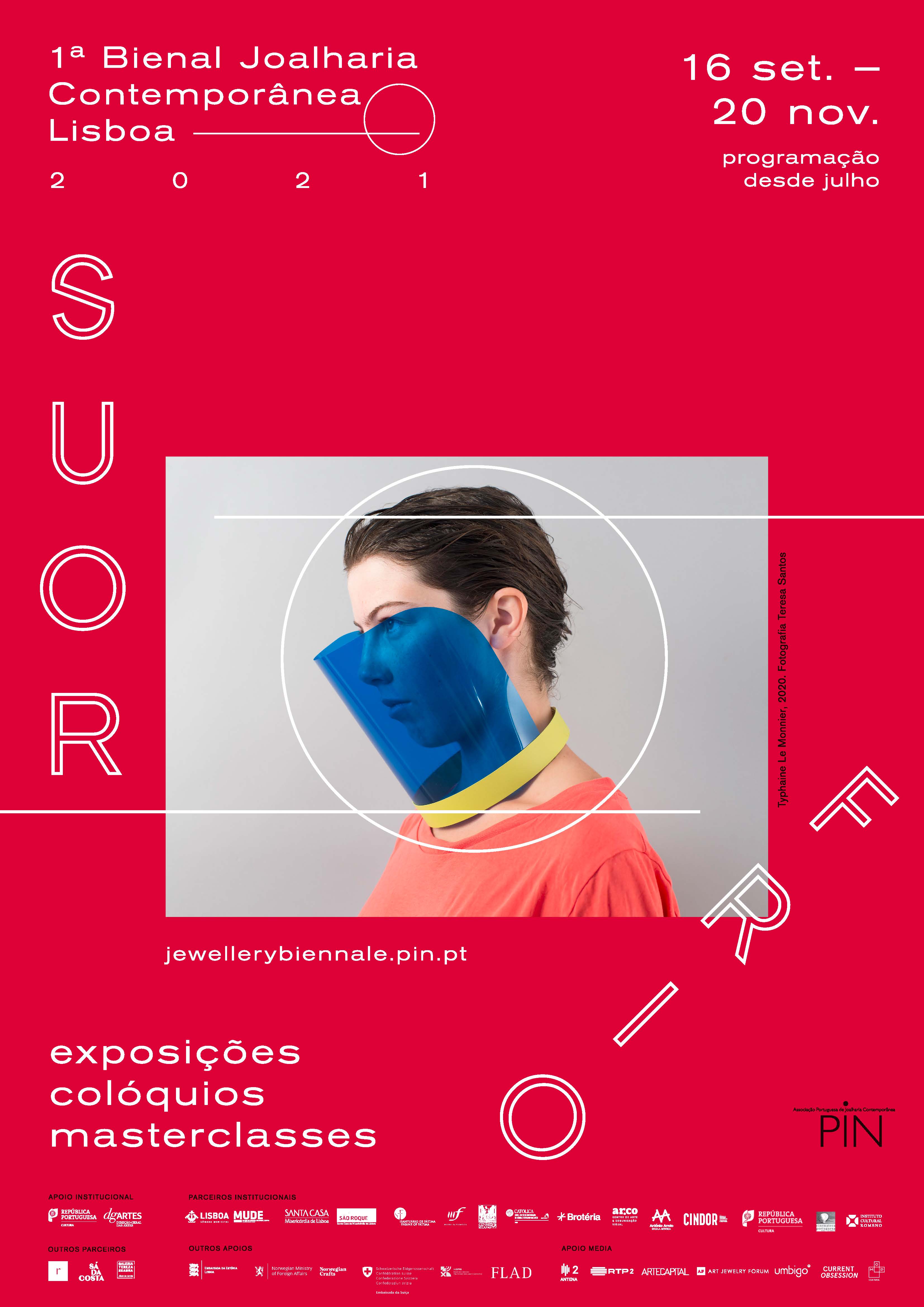PIN interview INYANIM GROUP
May 2013
Deganit Stern-Schocken, Tehila Levy-Hyndman, Kobi Roth, three elements of the Inyanim Group, were recently in Portugal for the opening of the exhibition Through Sources. It opened May 2nd and will last until June 14th at the Camões Instituto da Língua e Cooperação in Lisbon.
PIN invited the Inyanim Group to present their work in Lisbon, and for this occasion Deganit Stern-Schocken, mentor of the group, gave an overview of the history of contemporary jewellery in Israel, with a special focus on the work of the Inyanim Group, and led the workshop Fence in the jewellery department at Ar.Co.
PIN made the most of the presence of these three artists in Lisbon, talking about the story of the Inyanim Group, its objectives and the aspects that most characterize it. They also talked about jewellery design teaching in Israel and what these three artists thought of the current state of contemporary jewellery.
The conversation was conducted by Cristina Filipe (PIN). Eight questions served as the framework for an hour's conversation on the 8th of May at Cervejaria Trindade in Lisbon.
The Inyanim Group is composed by: Vered Babai, Shirly Bar-Amotz, Rory Hooper, Aviv Kinnel, Gregory Larin, Tehila Levi-Hyndman, Michal Oren, Kobi Roth, Dana Seachuga, Deganit Stern-Schocken and Edda Vardimon-Gudnason.

Kobi Roth, Deganit Stern-Schocken and Tehila Levy-Hyndman during the setting up of “Through Sources” at Camões.
© PIN
Does the world still need beautiful objects?
Deganit Stern-Schocken
1 › What does Inyanim mean?
Deganit: Inyanim is a Hebrew word that means affairs, issues. For us, this name means that we are dealing with things that are happening to other people, to us. We want our work to refer to actual problems, like political and social issues, and to take this medium of making jewelry further, beyond decoration, to give it some content. To build a ‘story’ about different dilemmas that we think are important.
I think that this language of making jewelry, which is a beautiful one, one that exists for thousands of years, can be useful even today for anyone who is in the world of art and design. We believe that creating with this language can be very meaningful, in addition to being beautiful.
So “inyanim” means affairs, and it builds all sorts of vocabulary that can deal with our efforts, with our creation.
Kobi: “Inyanim” is not a regular name. It is not a name, it’s a word.
Deganit: People used to say: “But this word (Inyanim) doesn´t say anything about the fact that the group deals with jewelry artists...”
In fact, it's just a word, it could fit any other group, and for me it's important that it doesn´t refer specifically to the jewelry world, because we're dealing with the borders of the field, the borders which we aim to stretch and trespass...
I think that we touch other spectrums like fine art, industry and even architecture. That's why the emphasis here is on the content, on 'affairs', not only the profession of making jewelry.
Cristina: But in your language, in each context do you use and reuse this word?
Deganit: You say this word (Inyanim) all the time.
Kobi: "Ma ah Inyanim?” means “How are are you doing?”

Ana Paula Laborinho, President of Camões Instituto with Deganit Stern-Schocken at “Through Sources” opening. © Eduardo Sousa Ribeiro
2 > “No Problem?” “Through Sources?” - What do they mean? For you, do the titles come at the beginning or at the end of the decision of having an exhibition? Are they a starting point for reflexion to create new pieces or are they a consequence of the work you decide to present?
Kobi: It depends....
Tehila: “No problem?” is a name that Deganit decided on...
Deganit: “No problem”... “question mark”!
Tehila: Kobi and I brought “Through Sources" because we decided that, for this exhibition at Camões, each artist will select his/her pieces...
This title means that each artist brings his/her essence of the work that they feel represents them now... their origin.
Deganit: the exhibition “No Problem?” started with another name - “Selected Tragedies” like the title of the book by Aeschylus, Sophocles and Euripides.
We wanted to connect this name to the political problems in Israel, but the first gallery we were going to exhibit in – Gallery Loupe in the States – reacted with shock. They could not understand how the name connects to jewelry. We changed it to “No Problem?”
I think this title is a kind of paradox. When you say: “No Problem!” you mean everything is fine. But when you put a question mark...which we did...it means: “Really? No problem?” Everything is a big problem...!
So again when you ask if we start with a name, we do not start with a name... we have this idea of dealing with deeper issues rather than just making nice jewelry...
Kobi: We also had another exhibition titled “Insight Guide” in Munich last year. The title referred to a tourist guidebook. There was a process regarding this book… Everybody in the group show different things, there are many voices. Sometimes the title of the exhibition comes first, sometimes it´s a process, and then we decide on the name.
The exhibition that Dana Seachuga organized in Amsterdam was part of the B-Side - Festival and there was no title, just an installation at her studio in Amsterdam, where she was living during that period.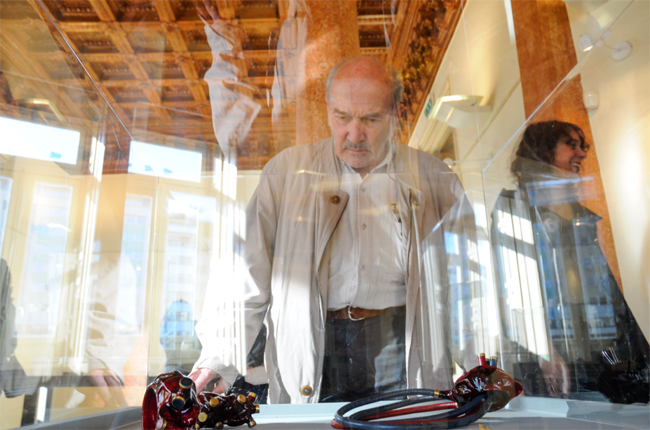
Jan Walgrave at “Through Sources” opening. © Eduardo Sousa Ribeiro
3 › What distinguishes the Inyanim Group from the rest of the contemporary jewellery art field in general?
Deganit: I have seen so many jewelry exhibitions around the world, and when I see the exhibition at Camões I see it is different... it is not all just beautiful.
You don´t go “wow, so nice”, like you say at a Lalique show for instance ...It doesn´t come from that angle at all...
I feel that there are also works that are harsh, that are more interesting than beautiful. There is a kind of a brave and provocative approach.
Cristina: you mean that the objects presented are not obvious?
Deganit: They are not obvious.... Some of them are difficult to bear...
Cristina: People cannot stay indifferent? They might not like it but they will always have a kind of reaction. At least they need to question themselves, in order to understand. It needs questions...?
Deganit: Exactly. Do you feel it yourself?
Cristina: Yes.
Tehila: I think that the fact that the group comes from Israel makes a difference. We are very different people, different artists, with different backgrounds...
Deganit: Yes. This is very important. The work explores very different political visions and different social backgrounds.
Tehila: We are not the same....!
Deganit: it is a very eclectic group, like the people in Israel.
Cristina: that's an important aspect - having the Inyanim group itself really represent the country – is that conscious or inevitable?
Deganit: In a way [it's conscious], but as an “after thought”. It was not intentional or inevitable!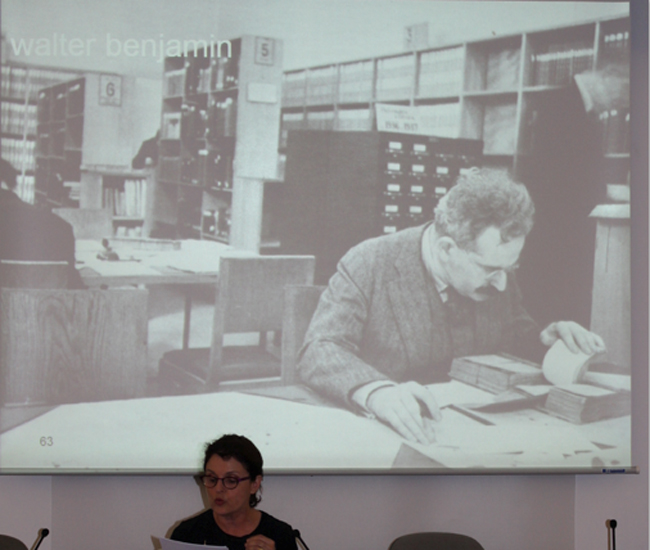
Deganit Stern-Schocken during her lecture “Made in Israel” at Camões. © PIN
4 > Who are your references that inspire you? Who are your “heroes”? Maybe you have different ones? Maybe from literature, fine arts, politics?
Tehila: I like Frida Kalo and Doris Salcedo, Christian Boltanski and Ilan Koren, a good friend of mine…but not a specific jewellery artist…
Deganit: I am more connected to literature, I think. Kafka for me is a reference. Absolutely. Paul Celan that I quoted in some of the pieces…and Agnon, the Nobel Prize laureate for literature, they are also relevant references.
Kobi: Sometimes it is text, sometimes a work of art. In my recent works I referred to Jasper Jones, but mainly for something that he said which was for me very important.
Deganit: And music for me is very important. Classical music, but not only…
Kobi Roth, 2012, “Leaders of The World”, A study for a necklace, silver. © Kobi Roth
5 › Is Inyanim a masculine or a feminine group?
Laughs...
Tehila: Feminine.
Deganit: The word Inyanim is masculine from the grammatical aspect of it.
Tehila: The spirit is feminine.
Cristina: If it were a human being, would it be a man or a woman?
Deganit: The word “INYANIM”, we cannot say it is feminine…. no sex!
Cristina: Hermaphrodite!?
Deganit: How many men do we have in the group?
Kobi: Three guys and the rest I suppose are girls (eigh)!
Cristina: So this contemporary jewelry phenomenal girl invasion also happens in Israel? In your schools as well?
Deganit: Yes!
Cristina: Do you have an opinion about that? Is there a reason for this phenomenon or reality?
Deganit: I can’t explain it, because traditionally it was mainly men making jewellery.

Tehila Levi-Hyndman, 2012, “Subala”, organic materials, bone , glue. ©Tehila Levi-Hyndman
6 › Why do you make jewellery? Why did you choose jewellery as a medium of expression? What are the advantages and the disadvantages of making jewellery?
Kobi: Why not jewellery? Relating obviously to Onno Boekhoudt, and also to the interesting conversation we had over dinner at your place.
Deganit: I studied Architecture and Industrial Design at Bezalel Academy in Jerusalem. Those two subjects were studied together at that time. But then a friend suggested that jewelry making may be the form of expression that fits me the most… It was a process to move to jewelry. In architecture you design, and each step takes a long time to produce, to make, to see and experience. With jewelry you're the boss, you control the situation, so I developed my own process, my own way.
Tehila: I started to learn shiatsu, a Japanese medicine, and during this process I started to feel my fingers and I felt that I should be doing something different with my hands.
Cristina: At what age did this happens?
Tehila: Twenty one.
Cristina: And how old are you now?
Tehila: Thrirty one. I have been making jewelry for almost ten years. After the shiatsu studies I felt that I should make something else with my hands and I went to a technological centre in Jerusalem to study jewelry techniques for one year, and then I went to Shenkar, where I studied for another four years.
Cristina: And did you have any idea about what was going on in the jewellery field when you started?
Tehila: No. I just felt I should go into that field.
Cristina: And was it a surprise or a shock when you got to know the field?
Tehila: No. When I went to the technical school I realised that it was not enough to only learn the techniques, which is why I decided to apply to Shenkar College of Engineering and Design.
Cristina: What is the balance between the apprenticeship of techniques and projects at Shenkar?
Deganit: We start with the same amount of hours doing technical studies and projects design. Students are asked to react to themes like beauty, ugliness, music, scale or movement and translate it into 3D objects. Then we move to deal with the body. We ask the students to make a piece of jewelry for a friend, or for a profession or for a cultural hero. Later we go deeper in the studies by having thematic projects alongside projects related to the industry.
Cristina: Do you have different teachers?
Deganit: Yes, Many different teachers.
Cristina: Does each group of students change teacher every semester? For how long do they have the same teacher?
Deganit: Sometimes a year, sometimes a semester. I think at the Bezalel Academy it is basically the same, no?
Kobi: I remember, in my time, one teacher was teaching us 11 hours a week, all year…. and it was horrible…. too much.
Deganit: It is important to say that at the Bezalel Academy, where Kobi studied (and I did), and at Shenkar as well, the emphasis is on design and art and not on being an expert in jewelry making.
At Shenkar we teach all the basic techniques in one year, very quickly, and then in the 2nd year we add some more specific techniques. But the emphasis is not on the techniques, as I said, but rather on thinking, creating and inventing. We direct the students to come to an idea from philosophy, literature, poetry, social and political issues and so on. What is quite unique for Shenkar though, is that in addition to their other studies, the students are learning the processes of the industry. We believe that on top of being thinkers, the graduates should have, as much as possible, the ability to earn their living. Learning the secrets of the industry helps them find their way outside of school.
Cristina: And at Shenkar you connect the two disciplines, the techniques and the projects?
Deganit: Yes, of course. One thing which is very important in both schools, Shenkar and Bezalel, is that one third of the studies are academic studies. The students hear lectures on different subjects like history of art, history of architecture, aesthetics, philosophy, and many other subjects…
Cristina: And does art history include jewellery?
Deganit: Yes. There is a special course about it.
Cristina: So you both, Kobi and Tehila, studied 4 years?
Deganit: Me too, but many years ago.
Cristina: But you studied architecture. Did you never study jewellery?
Deganit: Architecture and industrial design.
Tehila: When I came to Shenkar I didn´t want to make jewellery!
Deganit: …she came to the department of jewelry design, so she had to make jewelry! Now we have the Masters program (M.Des), a multidisciplinary program which includes different disciplines in design.
Cristina: Is it an MA specific to jewellery, or is it in association with other departments?
Deganit: it's in association with fashion design, textile and accessories. These are the official fields, but we accept graduates from other disciplines like architecture, graphics, art, etc....Now we are in the process of getting authorization to open M.Des programs also for industrial and graphic design. In the future all the departments will be part of the MA program.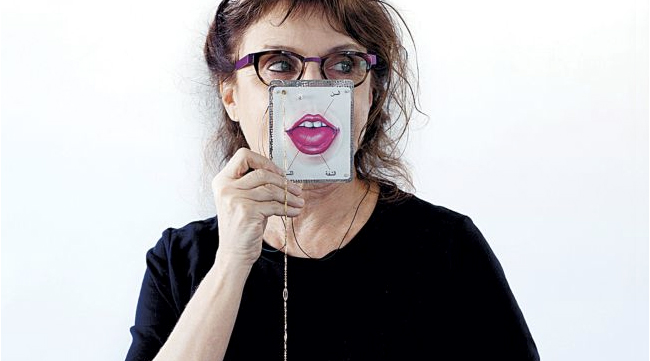
Deganit Stern-Schocken, 2012, portrait with necklace, from the catalog of the exhibition called 'I Am An Other' the 'Israeli Jewelry 6', was held at the Eretz Israel Museum, Tel Aviv. © Uri Gershuni
7 › What do you think about contemporary jewellery?
Deganit: That I want to sleep…what do you think about it?
Kobi: There is a lot of discussion about it!
Cristina: Jan Walgrave was saying something today during Deganit’s workshop presentation, that in contemporary jewellery today you are so concerned with visual expression, you forget about jewellery.
Kobi: Sometimes.
Deganit: I feel something else. I feel that what I see in Europe is mainly an overuse of new materials… materials are the subject, and for me, nice objects with extraordinary, exquisite workmanship and materials are not enough, something is missing. All these amazing objects mean very little to me, I must say. I am fed up with it! I see it at Schmuck and all over. Jewelry can and should express also ideas.
Cristina: …People are searching to surprise others, to innovate? Do you think this is the main goal? To make something really fresh and new that people have never seen before? Or do you think they are mainly focused on those issues in general?
Deganit: It is superficial and I am fed up with beautiful objects… It is a big question - to what extent does the world really need beautiful objects?
Why make jewelry? This is a big question.
I like jewelry because I can hide it, I can avoid seeing it…The main thing is that I can put it in a drawer or in my pocket, and then when I open the drawer it is like “Aladdin's cave”, it is always exciting, a moment of finding a treasure…This is an advantage of jewelry – being, generally speaking, small! The world is full of big sculptures which fill the cities and some of them are so ugly. Not to mention bad architecture, which we see all around. This is a problem.
Kobi: I agree with Deganit! I think there is too much going on with materials and the way you manipulate them…somehow it became “chic” and not more than that… I call it “contemporary jewellery chic”
Cristina: Chic meaning posh?
Kobi: meaning "contemporary Jewellery Style”.
Deganit: But there are beautiful things too…yesterday we looked at Paula's drawers at Galeria Reverso….
Kobi: Lots of interesting guys, lots of ideas…mainly concerned with the materials and the way it looks...
Cristina: Too superficial?
Kobi: …and it is getting more and more so…maybe because of the internet…you see more galleries, more sites…everybody puts a portfolio on the website and you see so much contemporary jewelry…
Cristina: Do you think there is a lot of contamination, people just quote each other?
Deganit: Sometimes it feels as if one person could do everything. In a way, people lose their identity.
Tehila: Because this is the time…
Deganit: Yes, the time and also the technology which offers such amazing possibilities. It is intriguing…
Cristina: But in the roots of jewellery, don´t you think this also exists? The ornament in itself?
Deganit: Yes. Yes.
Cristina: Now that we are talking about the things we see around us …do you think we can trust our eyes?
Deganit: What do you mean?
Cristina: Can we trust our eyes? Do you think what we see is enough?
Tehila: We see a lot…today.
Cristina: …yes, but when you see something through your knowledge, can you really judge someone's work? Are you sure that you know what it is about? Can we trust just our eyes these days?
Tehila: I think we should know the person. Not sometimes, always.
Deganit: To know the person? When we see a work of art we should have the tools to enjoy it. We don’t necessarily need to know the ‘stories’ behind it and we don’t always have to ‘understand’ the piece. There are different levels of experiencing a piece of art.
Tehila: It is not always like this…sometimes when you see the person, you see something else…
Deganit: Yes, that's true. But the chance to meet the artist while you see his exhibition is very rare…
Tehila: ...But you can meet them on Facebook today…
Deganit: …ah yes…but is it the same as meeting the person in reality?
Kobi: I think first there is the eye…
Cristina: The first impression...
Kobi: Yes…
Deganit: I have a picture of me with my eyes closed and with this picture I finish my lecture about my work...I say that the most important thing is to close your eyes and to try and not ‘see’…I believe it’s a good starting point....
Kobi: …I sometimes ask myself what´s the difference between fashion jewellery and contemporary jewellery these days…and I think everybody should ask this question, because it is a different field, and I think what we were saying about contemporary jewellery, a lot of the stuff in the market for contemporary jewellery is more fashion jewellery…
Deganit: For instance what we just saw at Paula’s gallery was a lot of fashion jewellery, a lot of beautiful stuff…
Tehila: Because they want to sell….
Kobi: In our group we don´t want to do fashion jewellery. It's not that we say: “No fashion Jewellery”…but what we’re doing, it's more about objects rather than about accessories.
Cristina: But the work gets more meaning when it is worn?
Tehila: No….
Deganit: That is a nice dilemma…I think it’s very different when it is exhibited as an object and when it is worn... The two ways support each other! I like to see, in an exhibition, jewelry/objects which are not worn! But then when you see it on a person it changes the whole experience…It is like with the students today, during the presentation of the results of the workshop “Fence”, I asked them to put it on, since their pieces were planned for the body, and it gave it another aspect, another angle…
But you asked before if what we see is what we see…and you kind of meant that people are cheating? That they are not honest?
Cristina: No, it was with a totally other meaning…I'll give you an example through a statement from a Portuguese psychologist who named a programme with a question, saying: “If you do not know, why do you ask?” and that means, that you need to know in order to somehow phrase questions…if you don't know, if you have no references, how will you understand what you're looking for…?
Deganit: I just bought an eraser at the Moma store in New York with a phrase written on it: “If it can be done, why do it?” Isn’t it an old issue, how educated should we be in order to create, or to experience, a work of art?
Cristina: today it's very tricky…as you just said before, there are so many things around…and it is very difficult to understand what is genuine and what is not…
Deganit: This is our role to find out, and for each of us, the answer of what is genuine and what is not, is different.
Cristina: But how do you deal with all the content that you put in a piece of work and the fact that 80% of the people do not get it?
Deganit: Well it was, and is, always for the elite…
Cristina: We have one of our famous artists who works with art history references, he only works with iron, and makes sculpture, and in the beginning of his career he did a big iron eagle as part of an installation, and the president of the Benfica Sport Club sent someone to go and buy the eagle, because it was the icon of the club….so how do you deal with this?
Tzvy *: Do you also want to choose the people that will buy it?
Cristina: …yes, that is my question! How far can you go as an artist? You work seriously on a concept…. that´s why I was asking if you can trust your eyes. I'll give you another good example, it happened just recently. I didn´t know much about the artists of the Inyanim Group. I mainly know you (Deganit)… And what I got from the exhibition were a couple of pieces from each artist, from which I could start to build a certain opinion. But, when Deganit gave me a little bit of information about where these people came from, what they did before, how did it change? The entire story changed for me…
Deganit: You mean my lecture changed it for you…
Cristina: Yes, absolutely. Because I didn´t know anything at all about the background, or about their previous experience. For instance Rory Hooper, Vered Babai, I couldn’t get to their work without your lecture and explanation…it absolutely changed my perception and my understanding of their work.
Kobi: I would like to go back to fashion jewellery, because it is important…The history of jewellery is about making objects which follow a certain style of clothing and Era, that´s the history of jewellery. People didn´t make jewellery as an object by itself.
Deganit: Certainly before modernism, art was a service to society.
Kobi: And here we are talking about jewellery that stands for itself with the ego of the creator…
Cristina: But in the fashion context, for instance in the 1980’s, there were disasters because there were some artists trying to do “new jewelry” which was not very conceptual…it was very much about materials and shapes, a certain deconstruction of traditional jewelry…but still mainly artistic, beautiful but strong in itself, and then came these people from the magazines to the Galleries to pick up your pieces and make a production with a photographer, models, etc….And like you said, how do you control this? Can you say: I do not want my work in this context! Or do I, because I want to be promoted, I want to sell my work…
The same when people come to a gallery and buy a piece, you have no idea how that person is going to wear it if it becomes a fashion piece, a decorative piece. You don't know, it depends…it's very hard to control…it's always on the borderline…and that´s why I think you cannot judge an artist by a unique piece…unless you see a big retrospective, or a big exhibition with a monographic catalogue, and you get a complete impression of an oeuvre. If you see two pieces, you cannot understand what it is about. It is not enough…your lecture was fantastic because it gave the roots of the group.
Deganit: When you release your work to the public you don’t have control over it anymore. That’s it.
Jewelry making - Jewelry designing, are languages of expression, so in that sense one can create with it a variety of creations. The same artist can make commercial things and at the same time very artistic objects which express all sorts of ideas, like in any other medium of art. And so, I don’t agree that the audience should always get the complete oeuvre at once of the creator.
Different pieces play different roles in different circumstances.
Cristina: Yes, it happens in every context, it is not a jewellery issue.
Deganit: No, it is not only a jewelry issue.
Tehila: right now, because of Facebook, the artists establish contact with the general public easily… Myself, I started to talk to people…people write me things…and you have responsibility for what you put on your page…when people want to see your work they can reach you on Facebook, this is the time…many people go to see the exhibitions and then go to Facebook and they can write to you. Today, if people want to contact the artist they use Facebook. 
Kobi Roth, Deganit Stern-Schocken and Tehila Levy-Hyndman during the opening of “Through Sources” at Camões. ©Eduardo Sousa Ribeiro
8 › What are the common points among the Inyanim artists and what are the contrasts? What are the similarities?
Deganit: The language of expression, generally speaking, is something we have in common. There is also a strong sense of collaboration. One needs a strong will in order to be part of a group, especially for people who are individualists! Even if the group does not meet often enough, it is something that you belong to.
On the other hand, it can create problems. It brings in ego issues, which reflect on all aspects of the work ...Being part of a group is like being in a marriage, you are dealing with a commitment, a common goal. You have to be able to make concessions. I am sure people have mixed feelings about it; sometimes they want to be there, sometimes they don’t.
Cristina: Nobody gave up?
Deganit: Not yet! But of course there are all kinds of obstacles. For instance, we have two people who are not living in Israel at the moment, so the communication with them is a bit different, even given the possibilities of the internet. Then we have two who recently had babies. So, there are objective reasons for people not to be all committed at all times. The ’Inyanim’ group is important, but it’s only one part of everybody’s life. For the time being we don’t give up on anyone.
Don’t you think this dynamic is true for any group?
Kobi: … and of course there are also prosaic circumstances.
Cristina: Just to finish, how many generations do you have in the group?
Deganit: Three. The group started in 2008 with 3 generations.
Cristina: Thank You!
* Tzvy Lupu is Kobi Roth’s partner and was present during the interview.

Deganit Stern-Schocken and Tehila Levy-Hyndman walking down Rua do Alecrim after the opening “Through Sources” at Camões. ©PIN
General view of the opening of the exhibition “Throught Sources” at Camões
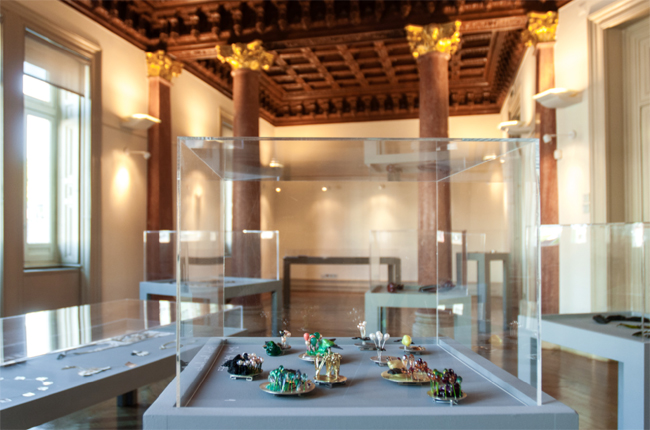
© Eduardo Sousa Ribeiro

© Eduardo Sousa Ribeiro

© Eduardo Sousa Ribeiro 
© Eduardo Sousa Ribeiro
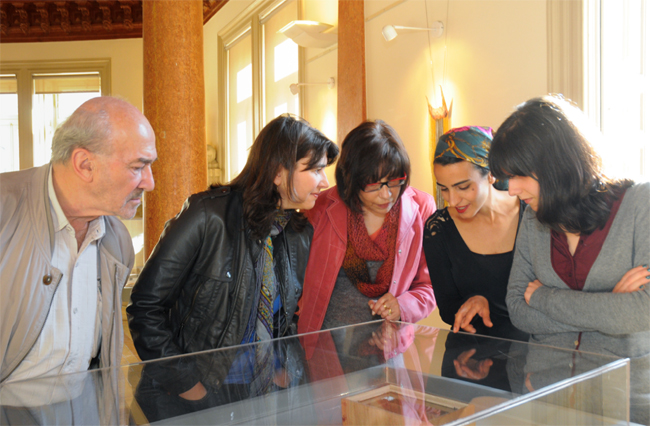
© Eduardo Sousa Ribeiro 
© Eduardo Sousa Ribeiro

© Eduardo Sousa Ribeiro
General view of the lecture “Made in Israel” at Camões

© PIN 
© PIN 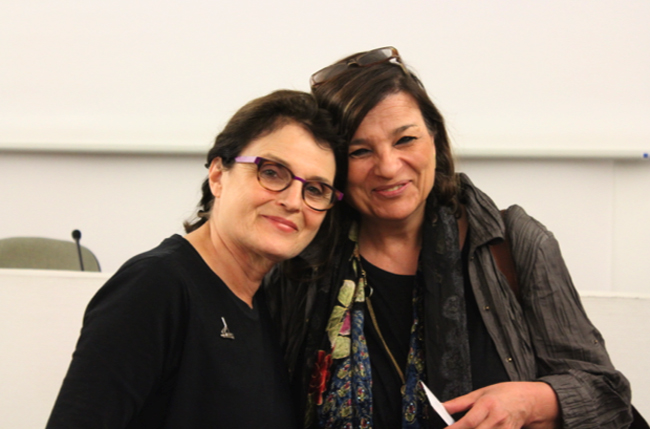
© PIN
General view of the Workshop “Fence” at Ar.Co

© PIN 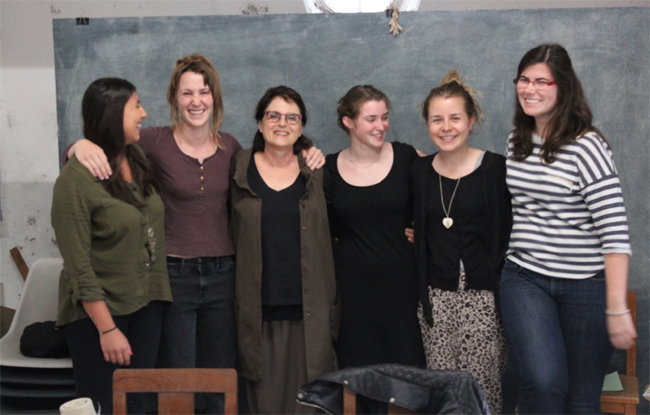
© PIN
+ info:
Exposição - “Throught Sources” | “Por entre as Fontes” aqui
Workshop de Joalharia com Deganit Stern Schoken aqui
Palestra - “Made in Israel” com Deganit Stern Schocken aqui

